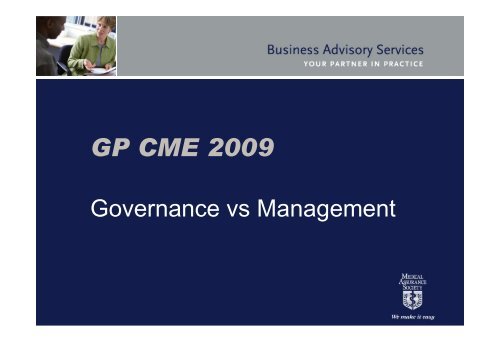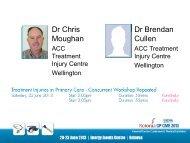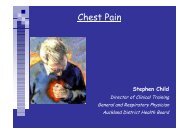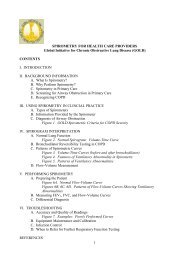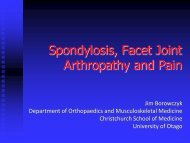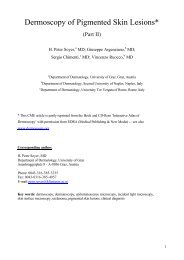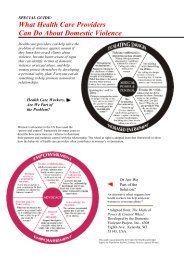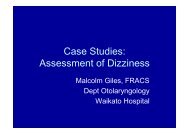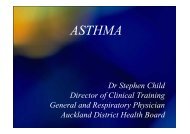Governance vs Management (PDF Format) - General Practice ...
Governance vs Management (PDF Format) - General Practice ...
Governance vs Management (PDF Format) - General Practice ...
You also want an ePaper? Increase the reach of your titles
YUMPU automatically turns print PDFs into web optimized ePapers that Google loves.
GP CME 2009<strong>Governance</strong> <strong>vs</strong> <strong>Management</strong>
Session Overview• <strong>Governance</strong>/<strong>Management</strong> – what’s thedifference?• <strong>General</strong> practice overview• A GP governance/management model• How do we get there (working together)• Questions
What is governance?• System of direction and control• On behalf of ‘owners’• Purpose – to ensure the organisationachieves what it should and avoidswhat is unacceptable
What is governance about ?• Setting clear direction• Defining policies and setting standards formanagement & governance• Setting objectives for practice and monitoringperformance• Ensuring capital is used efficiently, practice iscompliant and fulfils its obligations to owners, staffand society
<strong>Governance</strong> Model (Corporate)Legislation, regulations, constitution & otherobligations of the organisationThe BoardDirection Strategy PolicyCEO competence, capability & performanceMeeting expectations and requirements ofshareholders /owners
Good <strong>General</strong> <strong>Practice</strong> <strong>Governance</strong> –How do you know?• What are the primary performance measures ofthe practice? e.g. a corporate may be to ‘increaseshareholder value’• Assessment of overall board performance andindividual directors• Objective ‘to continually improve theeffectiveness of governance’
What is management?PlanningLeadingOrganisingControlling
What is management about?• Supports the board (governance) indeveloping strategic plan• Develops and recommends operationalplans (to achieve strategic goals)• Ensures the board has informationneeded to fulfil their responsibilities• Ensures the organisation implements theplans and policies, achieves goals etc.
GP Overview - Capitation FundingCapitation (more$$’s with financialrisk transfer)MOH/DHBOld funding – GMS.(Fee for service forpatient seen by GP)Based onenrolledPatientsPHOPHOCasual GMSGPGPGPGPOther GP’s& A/HoursClawback for patientsseen by other GPsOther GP’s& A/Hours
GP Overview - RevenueCapitation50%GMS5%Maty0%Imms1%ACC4%Third Party2%Where does the $ come from?FFS38%FFSCapitationGMSImmsMatyACCThird Party
GP Overview – sizeNumber of GP practices in NZ = approx. 1,000Sample = 418 <strong>Practice</strong>sAll <strong>Practice</strong>s< 2 GP FTE 2 - 4 GP FTE > 4 GP FTE(86 Rural, 332 Urban) Rural Urban Rural Urban Rural Urban Rural Urban<strong>Practice</strong> Numbers 86 332 33 129 38 151 15 52Ppn of sample 21% 79% 38% 39% 44% 45% 17% 16%Sample Medians:Patients per GP FTE 1,614 1,724 1,560 1,770 1,691 1,720 1536 1702Patients per Nurse FTE 1,750 2,214 1,560 2,028 1,885 2,267 1789 2403Nurse/GP FTE Ratio 0.92 0.77 1.00 0.83 0.79 0.75 0.84 0.74Admin/GP FTE Ratio 1.05 0.95 1.39 1.01 1.00 0.92 1.03 0.74*Source – MAS Healthy<strong>Practice</strong> - Subscriber Analysis Report – Jan 09
GP Overview – ownership• Ownership models have expanded. In addition to privatelyowned (GP & ‘corporate’) there are now PHO, DHB, CommunityTrust, Iwi and other ‘non-private’ sector ownership models• 2007 ‘Cornerstone’ survey of 444 practices had– 84% Privately owned, jointly owned or private company– 7% Community Trust (mostly rural?)– 3% PHO owned– 2% Tertiary Institute– 4% Other incl. Iwi, DHB
GP Overview – business model• Mostly private ownership and group practicegenerally still cost sharing arrangements• <strong>Practice</strong> ownership (patient goodwill) at individual GPlevel• <strong>Management</strong> role shared (GPs/<strong>Practice</strong> Manager/some staff)
GP Overview - Cost Sharing• Cost sharing group practice is still dominant• Each GP retains business ownership (their practice) &receives their revenue streams related to their patients• Capitation funds are received directly by individual GP(with/without internal clawbacks) OR internal/dummyGMS substitute• Group practice employs staff, manages the ‘costs’ &some group practice revenue. Levies GP owners withshare of net expenses
GP Overview - Cost sharingPatientsPatientsPayfor medicalcareChargesfor medicalcarePayfor medicalcareChargesfor medicalcarePractitioner/entity(owns patientgoodwill)Levies practice costsPays practice costs.Receives net revenueGroup <strong>Practice</strong>(employs staff,manages group practice)Levies practice costsPays practice costs.Receives net revenuePractitioner/entity(owns patientgoodwill)
GP Overview - Cost SharingBenefits• Fee for service model means GP take home income reflectspersonal activity/consults as well as enrolled base• Allows more independence of working practiceConcerns• More difficult to fairly reward for care of chronic illnesspatients, elderly or psychiatric• Tensions between what’s better for individual GP and thegroup• Fee for service model not so attractive for new GPs -many seek salary or sessional based rem.• More difficult to have good governance/managementmodel with a number of separate businesses?
GP Overview – Profit Sharing• More group practices considering single business optionbut cost-sharing arrangements still dominant• GP business & all assets owned by group• Clinical income & profit separation for owners• Financial risk (and return) held at group level
GP Overview – Profit SharingProvidesmedicalcarePatientsProvidesmedicalcarePractitioner/entityPays for contractedmedical servicesContracts to providemedical servicesPaysfor medicalservices<strong>Practice</strong> Company(Owns andmanages practice)Group practiceprofits - dividendsChargesfor medicalservicesContracts to providemedical servicesPays for contractedmedical servicesPractitioner/entityShareholders(GPs, Ownership Companies orfamily trusts)
GP Overview – Profit SharingBenefits• Clearer direction from owners with a single business• No more complex internal cost sharing arrangements• Focus switches to group practice performance as financial impact(profits/losses) is on all principals• Ability to manage all revenue opportunities and profit, not just costs• Should encourage better teamwork, consistency, group standardsand group practice complianceConcerns• Developing an equitable GP remuneration model• Less practice independence, acceptance of group standards
GP Overview - Environmental Changes• Capitated funding and proactive population healthmanagement• Increased financial risk• Less direct revenue from GP/patient consult• Group practice quality standards introduced• Increased compliance and administration• Business and management skill needs• Different business model required by younger GPs
Large <strong>Practice</strong> <strong>Governance</strong> & <strong>Management</strong> Model
Reporting to the BoardTypical board meeting agenda:1. Apologies & previous meeting minutes2. Matters arising3. Strategic plan progress report4. Sub-committee reporting– Finance– Clinical Quality– HR & Resources
Reporting to the BoardWhat will be your key measures forreporting to the principals?Group 1 – FinancialGroup 2 – Clinical QualityGroup 3 – HR and Resources
Summary & Questions?ResourcesMAS Healthy<strong>Practice</strong>®ContactManagerTelephonewww.healthypractice.co.nzMAS Business Advisory ServicesShaun Phelanshaun.phelan@medicals .co.nz0800 800 627 (MAS)


